Shipwreck S/S Thistlegorm
-
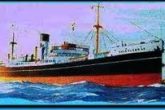
S/S Thistlegorm. -
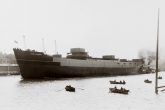
S/S Thistlegorm. -
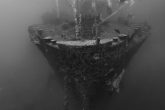
S/S Thistlegorm ( foto Alex Solich). -
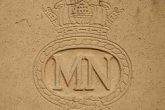
Badge of the British Merchant Navy. -
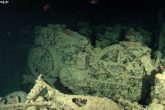
Bsa motorcycle. -

Bsa motorcycle. -

Bsa motorcycle. -
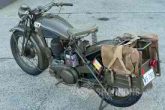
Bsa motorcycle. -
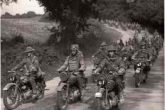
Norton motorcycle. -
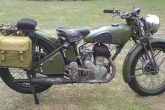
Norton motorcycle. -

Matchless motorcycle. -

Matchless motorcycle. -

Matchless motorcycle. -

The Bedford truck as it is today on the seabed. -
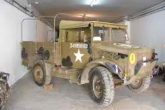
Bedford truck. -

Bedford truck. -
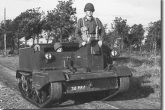
Bren Gun Carrier -

Bren Gun Carrier -
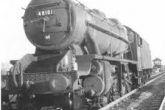
Lms Stanier class 8f. -

Lms Stanier class 8f. -
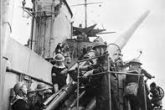
Anti-aircraft gun 4,7 inch. -

Bomber He 111. -
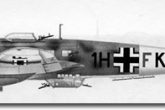
Bomber He 111. -

Video 01.From the shipwreck S/S Thistlegorm. -

Video 02.From the shipwreck S/S Thistlegorm.
After a very long and uneventful journey, the SS Thistlegorm was lying at anchor outside the entrance of the Suez Canal after slipping through the stormy waters of Atlantic Ocean, a route where, in 1941, German submarines were always on patrol, looking for an easy kill. The final destination was the port of Tawiq at the southern entrance of the Suez Canal, where the cargo was to be unloaded to supply the British troops in Egypt. It would have been easier and quicker to sail from Glasgow, where the freighter was loaded, through the Mediterranean and then down the Canal. But this route was much more dangerous. The Axis forces of Germany and Italy had increased their bombing against Malta and there was very little chance of getting through from Gibraltar to Alexandria. The risk was of contact with the enemy was much less by sailing through the Atlantic and round the Cape of Good Hope, even though that course was eight times longer.
The steam-powered freighter had joined a convoy of 16 other vessels to improve their chances of reaching their final destination without damage or loss. The SS Thistlegorm seems a strange name, but it was in the tradition of the old Scottish shipping company, the Albyn Line, which was founded in 1901, to name the vessels of that company with the prefix “Thistle”, the national flower of Scotland. To this name several Galic words were added, such as roy = red, or dhu = black. The coat of arms of the Albyn Line was a black thistle on a white back ground and it decorated all the funnels of the company’s ships.
The SS Thistlegorm was a typical freighter at this time and had a modern steam engine. She was christened Thistlegorm by Mrs. K.W Black on April 9th, 1940 at the shipyard of Joseph L. Thomson & Sons Ltd., North Sands Shipbuliding, Manor Quay Works in Sunderland, near the Scottish town of Newcastle. The final assembly of the freighter with the internal number 599 was completed in June 1940 and the vessel was registered with Lloyds of London under the number 84757. An increasing demand for merchantmen caused a boom in orders among the British shipbuilding industry as the government required new vessels for merchant shipping at the beginning of WW II. The experiences of WW I had proved the importance of a regular supply to the British Isles by sea. This was also underlined by the fact that at the beginning of the war, the Ministry of Shipping and the Ministry of Transport were integrated to a new Ministry of War Transport. The government had a great number of merchant vessels, but there were not enough for the new challenges in the war ahead. To cope with this lack of transportation, official orders to build more ships were given to private shipping companies, which were placed under the control by the new ministry. Due to the danger posed by hostile submarines and planes, many of these vessels were fitted with light guns for their own safety. Besides the regular crew, some gunners also joined the ships. They were naval soldiers put in charge of the handling and maintenance of the guns. Originally the SS Thistlegorm was not built for war action and there was insufficient armour plating of its vulnerable parts. So the bridge and other parts of the superstructure were reinforced with heavy concrete panels. From this, the ship was expected to get more protection against the machine- guns of attacking planes, and the heavy shelling of enemy warships. The SS Thistlegorm no longer looked a pretty vessel, but the armoured corset and the guns aft were necessary for her self-defense and to help her survive the risky trips at sea. The SS Thistlegorm had not been at sea very long. It was her fourth and last journey she would make under the command of captain Ellis. She sailed from Glasgow, where she was loaded in August 1941, and sailed to the Suez Canal via a stopover in Cape Town and Aden. This was a voyage of about ten weeks at sea between Scotland and its final destination. War supplies were stored in her four cargo holds. Light infantry tanks were parked under the decks next to big lorries with twin or triple axles. On their trays, workers lashed dozens of army motorbikes. Even the smaller four-wheel-driven cars were stuffed with supply goods, such as metal buckets, and other military equipment. Generators and single-axle trailers with water and fuel tanks stood in the corner holds next to spare wings for the Air Force. Plane engines, crates full of carbines, mines, grenades and smaller ammunition for the many 303 Enfield riffles were packed into crates.
Even bigger shells were stored amidships packed in crates for easy transportation. Huge shells, about 37 cm in diameter, for the guns of warships and coastal batteries were packed in the holds next to torpedoes and bottom mines. The fuses were stored separately next to hundreds of spare tyres for the cars and the motorbikes. There were also Wellington boots, radio-transmitters, uniforms, tools and other goods. On the main deck there was sufficient space for two mid-sized steam locomotives, with their tenders and two additional water wagons to increase their range in the desert. The SS Thistlegorm was like a floating ordinance depot when she left Glasgow on her last voyage.
OPERATION CRUSADER
The SS Thistlegorm was part of Operation Crusader, an important operation designed to maintain the supply of materials to the British Forces in North Africa. The goal of the British 8th army in mid November 1941, was to stop Rommel’s onward march and to push the Germans back to the west. Tobruk had been besieged since April 1941 and the British Forces aimed to halt the German tanks, conquer the Cyrenaika and to push forward to Tripoli. All in all the British had nearly 118,000 soldiers, 700 tanks, 600 artillery guns and 200 Anti-tank guns and plenty of other weapons and vehicles.
The British Desert Air Force consisted of more than 650 planes and supplies were in great demand for a force of this size. The supplies and equipment that were on board the SS Thistlegorm and the other vessels on the route from England to Egypt during the summer and autumn of 1941, were most important. Furthermore, troops had to be moved and new soldiers brought into the theatres of war in North Africa. To carry out such a huge transport of troops, civilian passenger ships like the Queen Mary were used. At this time she was on her way to Port Said with a contingent of Australian soldiers. For the German and Italian Air Forces those ships were an ideal target, as they were within the reach of their planes. At the beginning of Operation Crusader the British were successful to some extent in gaining territory, although they had to pay considerably in loss of men and war material. But the gains were shortlived as later, Rommel pushed forward until he took Tobruk on June 21st, 1942. The German advance towards Alexandria and Cairo looked inevitable but the advance was halted at the tiny village of El Almein.
THE ATTACK
On September 24th, 1941, the SS Thistlegorm joined the new convoy of about 20 ships (shouldn’t this be 16). Twelve days later she was lying at anchor at the entrance of the Gulf of Suez, with the other vessels of the convoy. She had cast anchor at the eastern side of the Gulf near Sha’ab Ali, close to the Inner Channel where she was guarded by the cruiser HMS Carlisle. Generally, the Inner Channel, names Anchorage F, was recognized as a safe berth, and was regularly used by allied shipping.
The SS Thistlegorm was temporarily prevented from sailing into the Canal because a tanker had run on a German mine close to the Canal’s exit at the Mediterranean. The entrance was blocked for some time, which was not unusual in those times. Since the occupation of Crete by German parachuters and the advance of German troops towards Alexandria, the Suez Canal and the northern areas of the Red Sea were very easy to reach by Axis Bombers. Air raids against Egyptian ports and vessels in the canal were commonplace. Again and again mines and bombs were dropped and British supply vessels were sunk or badly damaged.
The Germans aimed to interrupt the allies supply and transport in this region of the world and to disrupt regular shipping traffic in the Suez Canal. After ten days at Anchorage F, the crew of SS Thistlegorm was growing less attentive, as noted by Mr. Bansall, 3rd engineer of SS Thistlegorm in a letter he later wrote to the shipbuilder. The voyage had been without any serious incident and there were only few miles left to the final port of destination. The crew enjoyed playing cards or went for a swim in the calm, warm waters of the Red Sea. But German reconnaissance had already taken note that a big British convoy was on its way through the Red Sea towards Suez. They also knew important supplies were on board these ships. There were also rumours that the Cunard Liner Queen Mary was sailing the same route, loaded with thousands of Australian soldiers.
It was late at night and the moon was bright, leaving a silvery shine on the water of the Red Sea as the two bombers searched in vain for the Queen Mary. Due to the wrong timing information by the German command, the Queen Mary had not been located and slipped through, undisturbed, with Australian troops on board. The planes were reaching their maximum flight range and were forced to return home. One plane was flying along the mainland’s coast; the other one was heading directly home, close to the western shore of the Sinai Peninsula. Instead of the Queen Mary, the crew suddenly discovered some British vessels, freighters and other cargo ships, lying at anchor in the Strait of Gubal. These ships obviously belonged to the convoy that had been previously reported. The largest ships, SS Thistelgorm, were attacked immediately. The events that followed were reconstructed later by the statements of eyewitnesses and survivors. The air raid was a complete surprise. Most of the crewmen were already asleep, with many in hammocks on the main deck. It had been a hot October day and the crew was tired from the day’s intense heat on the ship’s steel deck. It was about 1.30am when the roaring of unknown plane engines were heard. The noise grew louder and louder. Nobody really believed that enemy planes could strike at this time of night. Neither did the crew of the HMS Carlisle, anchoring very close to the freighter. The Sinai bound He 111 was so low that it nearly touched the vessel’s booms. If the undercarriage had been released, it may have hit. The anti-aircraft guns of SS Thistlegorm were old fashioned and there was little chance of taking action. Also, there was no order to open fire on an unexpected enemy. The reason for this was simply because the crew were confident the ship would be guarded by the guns of the accompanying cruiser the guns of HMS Carlisle could not used either, for they were not positioned to fire at such a low angle. If they had, the cruiser would have hit its own upper structures or other vessels of the convoy.
CHAOS AND SINKING
Two bombs were released directly ahead of the target and at least one hit the ship’s side. The explosion blew a huge hole into the hull and the SS Thistlegorm shook heavily under the enormous blast. Chaos, death and devastation dominated the scenery. The following blaze and explosions were to be heard from the Egyptian mainland to the nearby mountains of the Sinai. Whether both bombs hit the vessel has not been proved or reported, but the hit was in the midship’s section, directly behind the bridge in the area of the fourth cargo hold, where the two locomotives were lashed.
The explosion had two serious consequences. First, the vessel’s engine, which was still under steam, exploded. Then, about ten minutes after the attack, most of the ammunition stored in this area went off. Grenades, mines and other explosives of big gauge guns were detonated. Destruction spread across the ship to the stern. Dennis Gray, gunner of HMS Carlisle remembered the situation very well as he was watching from his cruiser. He remembers especially the 303 Enfield bullets and tracers that shot into the dark sky like mini rockets. According to his statements, one of the two locomotives suddenly came off the main deck in a cloud of reddish sparks, heading right for the cruiser. It crashed into the sea with a big bang, close to HMS Carlisle. Everyone on board the attacked freighter, who was in that section, was killed instantly. Crewmen on the fore deck were able to release the two remaining lifeboats and to lower them down into the water. They picked up some of their comrades who had jumped from the stern into the sea. It was their last chance of survival as an escape to the bow was impossible. All the other lifeboats were blown to pieces by the shock waves and the following explosions.
THE ATTACKER
The Heinkel He 111 was developed as a heavy bomber and was recognized as the best bomber of the German Air Force during the first half of WW II. The He 111 was a very reliable plane, which had already been successfully used during the Spanish Civil War. Thirteen bomber wings and six more groups generally used the He 111 H in its basic version. Specially equipped with sophisticated radio systems, the Heinkel came into action as a so-called pathfinder plane and in another version it was widely used against sea targets.

